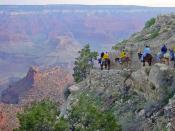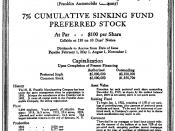9-17. Jack Hammer invests in a stock that will pay dividends of $2.00 at the end of the first year; $2.20 at the end of the second year; and $2.40 at the end of the third year. Also, he believes that at the end of the third year he will be able to sell the stock for $33. What is the present value of all future benefits if a discount rate of 11 percent is applied? (Round all values to two places to the right of the decimal point.)PV=[2(1/(1+.11)^1]+[2.2(1/(1+.11)^2]+[2.4(1/(1+.11)^3]+[33(1/(1+.11)^3]PV=2.22+1.28+.98+13.50PV=17.989.22 Your rich godfather has offered you a choice of one of the three following alternatives: $10,000 now; $2,000 a year for eight years; or $24,000 at the end of eight years.
a. Assuming you could earn 11 percent annually, which alternative should you choose?b. If you could earn 12 percent annually, would you still choose the same alternative?a. Choice 11st year$10,000*1.11=11,1002nd
year$11,100*1.11=12,3213rd year$12,321*1.11=13, 676.314th year$13,676.31*1.11=15,180.705th year$15,180.70*1.11=16850.586th year$16,850.58*1.11=18,704.157th year$18,704.15*1.11=20,761.608th year$20,761.60*1.11=23,045.38Choice 21st year$2,0002nd year$2,000+($2000*1.11)=42203rd year$2,000 + (2000 * 1.11)+(2000*(1.11^2)=6684.204th year$2,000+(2000*1.11)+(2000*(1.11^2))+(2000*(1.11^3))=9419.165th year$2,000+(2000*1.11)+(2000*(1.11^2))+(2000*(1.11^3))+(2000*(1.11^4))=12455.606th year$2,000+(2000*1.11)+(2000*(1.11^2))+(2000*(1.11^3))+(2000*(1.11^4))+(2000*(1.11^5))=15825.727th year$2,000+(2000*1.11)+(2000*(1.11^2))+(2000*(1.11^3))+(2000*(1.11^4))+(2000*(1.11^5))+(2000*(1.11^6))=19566.558th year$2,000+(2000*1.11)+(2000*(1.11^2))+(2000*(1.11^3))+(2000*(1.11^4))+(2000*(1.11^5))+(2000*(1.11^6))+(2000*(1.11^7)) =23,718.87Assuming I could earn 11% a year, I would choose to receive $24, 000.00 at the end of the eight years.
b. Choice 11st year$10,000*1.12=11,2002nd year$11,200*1.12=12,5443rd year$12,544*1.12=14,049.284th year$14,049.28*1.12=15,735.195th year$15,735.19*1.12=17,623.416th year$17,623.41*1.12=19 738.227th year$19,738.22*1.12=22,106.818th year$22,106.81*1.12=24,759.63Choice 21st year$2,0002nd year$2,000+($2,000*1.12)=42403rd year$2,000+(2000*1.12)+(2000*(1.12^2))=6748.804th year$2,000+(2000*1.12)+(2000*(1.12^2))+(2000*(1.12^3))=9558.665th year$2,000+(2000*1.12)+(2000*(1.12^2))+(2000*1.12^3))+(2000*(1.12^4))=12 705.696th year$2,000+(2000*1.12)+(2000*(1.12^2))+(2000*(1.12^3))+(2000*(1.12^4))+(2000*(1.12^5))=16 230.387th year$2,000+(2000*1.12)+(2000*(1.12^2))+(2000*(1.12^3))+(2000*(1.12^4))+(2000*(1.12^5))+(2000*(1.12^6))=20 178.028th year$2,000+(2000*1.12)+(2000*(1.12^2))+(2000*(1.12^3))+(2000*(1.12^4))+(2000*(1.12^5))+(2000*(1.12^6))+(2000*(1.12^7)) =24 599.39Assuming I could earn 12% a year, I would choose to receive the $10,000.00.
9.23 You need $28,974 at the end of 10 years, and your only investment outlet is an 8 percent long-term certificate of deposit (compounded annually). With the certificate of deposit, you make an initial investment at the beginning of the first year.
1. What single payment could be made at the beginning of the first year to achieve this objective?2. What amount could you pay at the end of...


